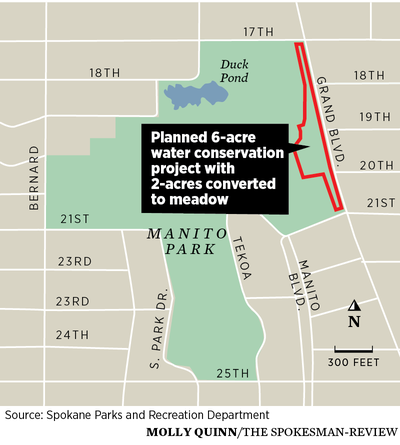Where the wild things will grow: 2 acres of Manito to be coverted to natural meadowland

The rose garden. The lilac garden. And soon, a Spokane meadow.
The eastern edge of Manito Park will undergo a transformation this summer, highlighted by the conversion of two acres of grass turf into natural meadowland, with the goal of reducing water usage at the historic park.
“We really envision it as another type of garden at Manito,” said Nick Hamad, a landscape architect with Spokane Parks. “This is a way to showcase our more native landscape.”
Starting next week, the city’s parks department will start work on a water conservation project in a six-acre portion of Manito Park that will also include the planting of wildflower gardens and the introduction of maintenance-friendly “Spokanescaping” to areas along Grand Boulevard.
The work is all part of the department’s ongoing efforts to conserve water, a directive of the city’s strategic plan adopted in 2018. To date, that work has focused mostly on massive changes to Spokane’s municipally owned golf courses.
Irrigation efforts at Indian Canyon Golf Course led to a 30.5% reduction in water usage there in 2019 compared to the three-year historical average. Upgrades to Esmeralda Golf Course are expected to reduce water usage by about 18% this year.
Water conservation projects in the city’s parks were identified, in part, based on their likelihood to save about 30% or more of water consumption.
Not only is there opportunity for less water usage at Manito Park, the department could also see a cost savings. Currently, the area encompassed in the upcoming project is manually irrigated, which not only results in labor costs but reduces daytime access to the park when watering occurs.
Crews are expected to be at the site from next week through June 1, but only a portion of the area will be fenced off to public access during the project.
Known locally as “Spokanescaping,” rocks and plantings will replace the tough-to-mow hillsides in the park adjacent to the Grand Boulevard sidewalk. The work will not force the closure of the sidewalk.
Hamad described the section of the park eyed for meadowland as being used most commonly for reading, quiet contemplation and picnicking.
“That’s the character we want to preserve in that place,” Hamad said.
Native grasses simply make sense for that section of Manito, parks officials argue. Growing turf atop the hill is quite difficult, Hamad noted. It’s heavily shaded with shallow soil.
“It wants to be a more native type of landscape,” Hamad said, adding the plan it to work “with nature instead of against it.”
The native grass mix will consist of 40% sodar streambank wheatgrass, 20% Sandberg bluegrass, 20% Idaho fescue and 20% bluebunch wheatgrass.
A portion of the six-acre area will be set aside for wildflowers. Parks will start by planting a mix of flowers they believe will grow well and will adapt as necessary.
The meadowland concept could spread to other areas of Manito if it’s successful, but Hamad stressed that it would be in low-traffic, rocky areas.
“We’re not looking at converting large areas of turf to meadow,” Hamad said.
The water-friendly meadowlands could be a future option for other city parks. Parks Director Garrett Jones noted that High Bridge Park has areas of highly maintained turf that is fairly difficult to grow, including along steep hilltops.
“As far as scale, these could be very small installations or fairly widespread,” Jones said.
Sky Prairie Park on the city’s north side also features native meadowlands with walking paths meandering through, Jones noted.
These types of landscapes ultimately require less maintenance than their turf counterparts, according to Hamad.
Hamad acknowledged that fire in a native landscape is always a concern, but said that a new irrigation system with a sprinkler will prevent Manito’s meadow from drying out too much. It will still be mowed a couple of times a year, he added.
In total, the project will result in four acres of new irrigation coverage in Manito Park, leading to a projected 30% reduction of water usage.
Manito’s prominence in the city’s park system is part of why it was chosen for a water conservation project.
“It’s going to get a lot of eyes and comments,” Jones said.